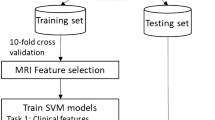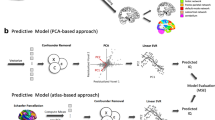Abstract
In response to the ABCD Neurocognitive Prediction Challenge (ABCD-NP-Challenge 2019), we developed machine learning algorithms to predict the fluid intelligence (FI) score using T1-weighed magnetic resonance imaging (MRI) data. 122 volumetric scores of regions of interest from 3739 samples provided in the training set were used to train the models and 415 samples were assigned as validation samples. We performed feature reduction using principal factors factor analysis on the training set volume. 36 factors explaining 100% of the total variance were extracted; the top 18 explained 80% of the variance. We estimated three types of models based on: (1) all regional brain volumes, (2) the 18 top factors or (3) the 36 complete factors. We used Scikit-Learn’s grid search method to search the hyperparameter spaces of eight different machine learning algorithms. The best model, a Nu support vector regression model (NuSVR) using 36 factor scores as features, yielded the highest validation score (R2 = 0.048) and a relatively low training score (0.22), the latter of which was important for reducing the degree of over-fitting. The mean squared errors (MSEs) for the training and validation samples were 68.2 and 68.6, respectively; the correlation coefficients were 0.54 and 0.21 (p < 0.0001 for both). The final MSE for the test set was 95.63. Learning curve analysis suggests that the current training sample size is still too small; increasing sample size should improve predictive accuracy. Overall, our results suggest that, given a large enough sample, machine learning methods with structural MRI data may be able to accurately estimate fluid intelligence.
You have full access to this open access chapter, Download conference paper PDF
Similar content being viewed by others
Keywords
1 Introduction
Fluid intelligence (FI) is refers to the ability to reason and to solve new problems independently of previously acquired knowledge [1]. Many studies have examined the correlations of brain anatomical structures with human intelligence [1,2,3]. Deciphering the neural mechanisms underlying human intelligence is important for understanding neurocognitive development and has fundamental implications for education and clinical work. For example, different brain regions and anatomical differences have been associated with different learning abilities. In children, anatomical differences in hippocampus and associated learning and memory regions predicted difference in math skill acquisition [4]. In adults, video game skills were linked to striatal volumes [5] and foreign language skills were linked to white matters of the left insula/prefrontal cortex and inferior parietal cortices [6]. Better characterization of brain biomarkers for different cognitive functions may facilitate the development of targeted training and intervention programs for both typically developing children and those with developmental disabilities.
As the largest long-term study of brain development and child health in the United States [7], the Adolescent Brain Cognitive Development Study (ABCD) Consortium invited researchers to participate in their Neurocognitive Prediction (NP) Challenge. Contestants were asked to use structural MRI data acquired from the study to predict fluid intelligence scores. For the NP Challenge, data from 4154 subjects were provided to participants for training (3739 samples) and validation (415 samples). Data from 4515 additional subjects was reserved as the test set. This report describes the results of our machine learning analyses of these data.
2 Methods
2.1 Dataset and Features
Fluid intelligence (FI) scores were pre-residualized by the Challenge organizer to remove the effects of total brain volume and sociodemographic variables including data collection site, age at baseline, sex at birth, race/ethnicity, highest parental education, parental income, and parental marital status. FI scores from the training and validation sets were provided to contestant during the challenge. 122 regional brain volumes were provided by the Challenge organizer for all samples from the training, validation and test sets. Briefly, the skull stripped MRI images were affinely aligned to the SRI 24 atlas [9], and segmented into regions of interest according to the atlas using standardized processing pipelines in the ABCD Study (details see [10]).
We factor analyzed the training set, and 36 principal factors were identified to account for 100% of the variances with the top 18 factors accounted for 80% of the total variances. Varimax rotated factor scores were generated for the validation and test sets based on the training set factors. In addition to the MRI volumetric scores and factor scores, we included age and sex as features as they are universally available information. All input features were scaled based on the training set’s minimum and maximum values.
2.2 Statistical Machine Learning Methods
Eight different algorithms were investigated using Scikit-Learn’s grid search tool for hyper-parameter optimization: random forest regressor (RFR), stochastic gradient descent regressor (SGD), Lasso linear model with least angle regression (LassoLar), elastic net (EN), multilayer perceptron regressor (MLP), Ridge regression (Ridge), support vector regression (SVR) and Nu support vector regression (NuSVR) with linear, poly or sigmoid kernel. See the Scikit-Learn online documentation for detailed hyper-parameters available for tuning using grid search tool (https://scikit-learn.org). During grid search, models were optimized using the R2 coefficient of the validation samples. R2 is defined as follows:
where u is the residual sum of squares
and v is the total sum of squares
A perfect prediction will have a score of 1.
We compared the training and validation R2 scores for different models using different input features. The best model was chosen based on having the highest validation score and the lowest training score that was as good as or better than the validation score. We used the latter decision rule to reduce overfitting.
Prediction of FI scores was obtained by fitting training data to the best model and obtaining the predicted values (ypred). The predicted results were also evaluated with the mean squared error (MSE, requested by the Challenge organizer, see below) and correlation coefficient with the true FI values (ytrue):
2.3 Learning Curve Analyses
Learning curves were generated by using deciles of the total training sample to fit the model. For each decile of sample size, we plotted the training and validation R2. We use learning curve analysis to evaluate the model’s bias and variance, as well as the sample size effect. This helps to draw inferences about how models might be improved in the future [11].
3 Results
3.1 Grid Search Results
The grid searches of hyperparameter spaces for eight models using three different feature sets returned 24 sets of training and validation R2 scores (Fig. 1). Each dot within each of the 24 sets represents one specific model with a unique set of hyperparameters setting. NuSVR had the highest validation scores (the highest R2 = 0.046). RFR ranked second, but was considerable lower (the highest R2 = 0.029). None of the other models yielded predictions with R2 above 0.02. Thus we only considered the NuSVR model further. For NuSVR, the best feature set used the 36 principal factor scores as inputs. The best hyperparameters were: gamma = 1, nu = 0.2, C = 10, kernel = ‘rbf’.
3.2 Prediction Results
Using the best NuSVR model, we predicted the FI scores for the training and the validation sets. Predicted scores were plotted against the actual FI scores (Fig. 2). The scores were significantly correlated (r = 0.54 for the training samples and 0.21 for the validation samples (p < 0.0001 for both). The mean squared errors (MSE) for the training and validation samples were 68.2 and 68.6, respectively. Removing age and sex as predictors from the model yielded a slightly higher MSE (70.5), but the predictions was significantly different from the original prediction (F(1, 17314) = 0.72; p = 0.4).
3.3 Learning Curve
The learning curve plots the training and validation R2 for 10 incremental sample sizes (at 10% increments) up to the total number of samples. In an ideal model, with increasing sample sizes, the training and validation scores should gradually converge. We found, however, that our training and validation scores did not fully converge, suggesting that model has some degree of over-fitting at the current sample size and that increasing the training sample will be needed to improve the accuracy. Having more predictive features or using current features in a more efficient way could also increase accuracy (Fig. 3).
4 Discussion
Using the structural MRI data provided by the ABCD NP Challenge organizer, we developed statistical machine learning algorithms to predict fluid intelligence scores. We identified NuSVR to be the best prediction model and found that using 36 principal factors yielded the highest prediction accuracies. The predicted FI scores were significantly, albeit modestly, correlated with the actual scores. Our results show the promise of using structural MRI data to predict fluid intelligence and support prior findings of strong anatomical correlations of brain structures with human intelligence. However, we also found that current sample size is not adequate and that more training samples will likely help to improve the model’s prediction.
In addition to the sample size limit, we also note that we did not use the T1-weighted MRI images that were also provided for the Challenge. Methods such as convolutional neural networks may be able to extract useful features from the three dimensional MRI images. Such methods may help improve prediction accuracies.
References
Jaeggi, S.M., et al.: Improving fluid intelligence with training on working memory. Proc. Natl. Acad. Sci. U.S.A. 105(19), 6829–6833 (2008)
Li, Y., et al.: Brain anatomical network and intelligence. PLoS Comput. Biol. 5(5), e1000395 (2009)
Wang, L., et al.: MRI-based intelligence quotient (IQ) estimation with sparse learning. PLoS ONE 10(3), e0117295 (2015)
Supekar, K., et al.: Neural predictors of individual differences in response to math tutoring in primary-grade school children. Proc. Natl. Acad. Sci. U.S.A. 110(20), 8230–8235 (2013)
Erickson, K.I., et al.: Striatal volume predicts level of video game skill acquisition. Cereb. Cortex 20(11), 2522–2530 (2010)
Golestani, N., Pallier, C.: Anatomical correlates of foreign speech sound production. Cereb. Cortex 17(4), 929–934 (2007)
Feldstein Ewing, S.W., Bjork, J.M., Luciana, M.: Implications of the ABCD study for developmental neuroscience. Dev. Cogn. Neurosci. 32, 161–164 (2018)
Pedregosa, F., et al.: Scikit-learn: machine learning in python. J. Mach. Learn. Res. 12, 2825–2830 (2012)
Rohlfing, T., et al.: The SRI24 multichannel atlas of normal adult human brain structure. Hum. Brain Mapp. 31(5), 798–819 (2010)
Pfefferbaum, A., et al.: Altered brain developmental trajectories in adolescents after initiating drinking. Am. J. Psychiatry 175(4), 370–380 (2018)
Webb, G.I., et al.: Learning Curves in Machine Learning, pp. 577–580 (2011)
Author information
Authors and Affiliations
Corresponding author
Editor information
Editors and Affiliations
Rights and permissions
Copyright information
© 2019 Springer Nature Switzerland AG
About this paper
Cite this paper
Zhang-James, Y., Glatt, S.J., Faraone, S.V. (2019). Nu Support Vector Machine in Prediction of Fluid Intelligence Using MRI Data. In: Pohl, K., Thompson, W., Adeli, E., Linguraru, M. (eds) Adolescent Brain Cognitive Development Neurocognitive Prediction. ABCD-NP 2019. Lecture Notes in Computer Science(), vol 11791. Springer, Cham. https://doi.org/10.1007/978-3-030-31901-4_11
Download citation
DOI: https://doi.org/10.1007/978-3-030-31901-4_11
Published:
Publisher Name: Springer, Cham
Print ISBN: 978-3-030-31900-7
Online ISBN: 978-3-030-31901-4
eBook Packages: Computer ScienceComputer Science (R0)







